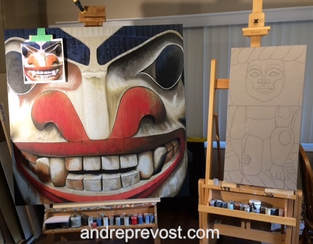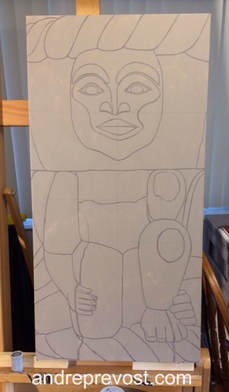|
It has been slower going in recent weeks. There are those dips in the road where an artist feels the weight of the work and the pressure of trying to support ones family and its medical needs. But even if the progress hasn't been as well as I would like, it is important to trudge along in any case, and work through it. I was tackling the detailing of the Brown Bear Totem painting, but I was overtaken by the need to begin another totem section. This has been an essential part of this journey with the totems, allowing them to draw me, each in their own time. In light of the dialogs around appropriation concerns, with concerns of First Nations designs being used or re-interpreted by non-Indigenous artists or companies as an example, mine is not to create new artworks in the conventional sense. Mine is not to interpret. I suppose that this self-discipline comes from my years in Byzantine Iconography, where to, I have always trusted the Masters and respected the forms, traditions, symbolism, colours, etc. In doing so, my works avoided error and inadvertently posing questions or scandal. The same can be said for this series, this journey with the totems. I allow myself to respond and to use my skills to capture what I see, and all the details within. It is imperative that I keep adjusting the forms and lines as required, until they are as exact as need be (aware of how precise these forms are from Nation to Nation, imparted with their meaning and movements). I trust the image of the totem and the Master's creation. My task is to capture a facet of a particular moment in time within a totem's life span, preserving the Master's vision and skill. And unlike a photograph, the canvas painting brings a viewer, while remaining true to the original totem, an experience of vibrancy from the totem; the same which I feel when I come in contact with it in real life. So, being free from trying to come up with an artistic concept for a painting, I can follow the images of various totems as they beckon. And they do. This new canvas is a case in point. I had been considering a few options, keeping in mind the canvas sizes that I had on hand. One of my JPEGs was from the second lower layer of the House Pole at the Capilano Totem Visitors Center, "Seventh Generation Pole / Honour of the Children Pole". It seems simple enough but the forms and textures within and subtle colourings are actually complex in their simplicity. The background information about this Totem is as follows:
0 Comments
Tlinghit Wolf Totem, 2017 24” x 36” x 1.5” ‘Wolf Totem Pole: Everyone’s Grandfather’ was raised at the Fairbanks University of Alaska Museum in 1988. The pole honors the wolf clan and was named by George Dalton, Elder of the Kaag Waan Taan (Wolf) Clan. The 20-foot pole is made of western red cedar from Ketchikan and features the three figures of eagle, wolf, and bear. This particular totem pole honors the traditional teaching method of a master artist working alongside his apprentices. * The name of the carver(s) unknown. ~ ~ ~ ~ ~ ~ When I did the first painting of the Wolf painting in 2015. I had assumed that what I was seeing was a coat of a dark stain which had been added to replicate a black wolf. But then, I later came across an image of the same totem by the Alaskan photographer Patrick Endres. It was bright and with no sign of a dark patina. It wasn't until I volunteered to assist Carey Newman with his Spirit Pole restoration, that I discovered what was really at play. The Spirit Pole, because of its location on the perimeter of a parking lot and nearby drive through, the totem had absorbed the carbon emissions which gave it a very dark patina, unlike the normal grey patinas of aging cedar. The initial sanding that was done, prior to restoring the paint, removed the carbon and restored the cedar to it natural colour. To confirm this with this new image of the Wolf Totem, it was indeed taken early after its installation, and the carbon emission absorption was still minimal. So in keeping with the 'Time Capsule' component of this totem series, the two totem paintings are distinct moments in the totem's life, and which quickly changes within its cycle. This image had its own challenges, as you can see in the different colour ranges and textures which were new to me (in how to replicate them in my technique). There are always times when you have to reglaze over an area with the undertone in order to rework the the top layers. ~ ~ ~ ~ ~ ~ During my first exhibition of the Journeying With The Totems series in January-February of 2015, I was able to be onsite on a somewhat regular basis, to meet with viewers, answer their questions, and talk about the series. I set up a small easel in one corner so that I could paint during the quiet times, especially in the heavier rains of the season. It allowed me to be in the space without encroaching on the viewer(s) space while looking at the paintings. They could come and see what I was doing without feeling like I was like a 'saleman' in a store. It was a wonderful time as; here I was in the Silk Purse Gallery, with its wonderful view of English Bay, and with Eagles in the nearby tall cedars. I made a point of savoring every moment, imagining what it would be like to have a studio like this all the time. But it is only a temporary dream after all. One cherished memory was the day of setting up the show. It was pouring rain. As I waited for the staff to arrive to open the gallery, I was feeling a bit glum standing in the rain, when I started to hear an eagle loudly vocalizing from the top the tree next to the gallery. It lifted my spirits and I understood this moment as a good omen. I had chosen to work on a smaller canvas this time, as I wasn’t sure how much time I would have, and I needed an image that could accommodate a lot of interruptions. The larger images become almost impossible to do when my time is disjointed. For those, I need focused time in order to make progress. You just can’t jump in and start painting. Not with the realistic totems anyway. Having completed the Eagle-Raven Shield painting, I was interested in a wolf totem that I had seen on the Fairbanks University website. I hadn’t worked on a wolf before and I loved the composition of this particular totem. It did pose a new challenge though. The wolf totem itself had been given a black stain and so I had to factor that and how it played with the wood underneath. Because of the narrow size of the canvas, I chose a cropping of the face which reminded me of a Bateman painting a number of years ago, where he depicted a black wolf peering from behind a tree in a winter setting. I liked the strength of the one eye looking at you, the beauty of the upper composition and the menacing of the mouth. I did manage to complete this painting during the four weeks I was in the Silk Purse Gallery. As I continue to work on the detailing on the large Brown Bear totem painting, the lower section of the Brown Bear story totem at Capilano Suspension Bridge, I've started inking in a canvas of the lower section of the House Pole at the Capilano's Visitor's Centre. I've always loved this section's colouring and textures. But unfortunately, I've yet to find the descriptions of all the stories and crests contained in this totem.
The Tlingit Totem painting has been completed. I will varnish the painting after delivering the St. Kateri icon to Horseshoe Bay tomorrow morning.
When I received the request to paint another 12"x36" of the Tinglit, as a pair to the Beaver Detail, I clarified that I would do the painting from my reference photograph of the totem, rather then doing a copy of the previous painting, and let it guide the way. Because of the realism of my style, the two are actually very similar. The painting will be delivered to JD Stevenson Gallery this weekend. |
Archives
November 2020
|









 RSS Feed
RSS Feed